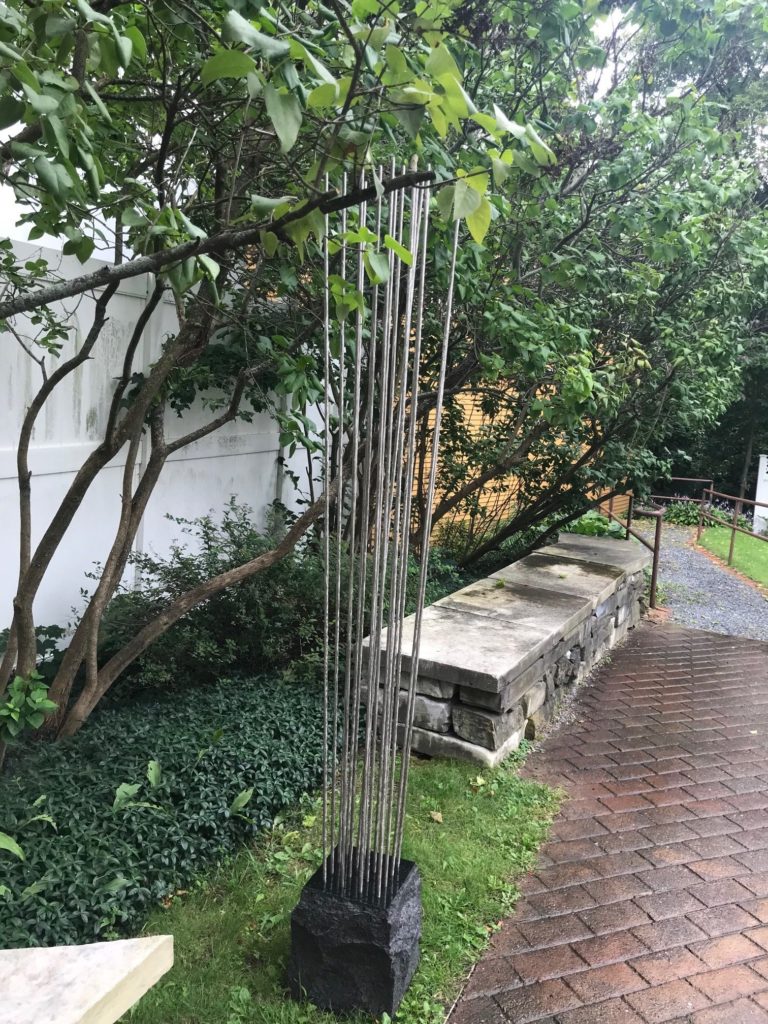
MIDDLEBURY— Since 1966 the garden at Middlebury’s Sheldon Museum has served as a relaxing, quiet escape for visitors to enjoy the colorful, period flowers and plants. Volunteer members of the Middlebury Garden Club have designed, planted, and cared for the garden for decades. The garden is open to visitors from sunrise to sunset.
Five new sculptures by three Vermont artists have been added to this in-town, outdoor oasis. At the entry John Matusz of Waitsfield has installed his “Interrogative Statement #9,” of welded steel, metamorphic stone from the Mad River, and three colorful chunks of discarded ornamental cullet glass. From these repurposed materials Matusz creates works of art that critic Ric Kasini Kadour described as “sensual and mighty, simple and glorious.” When explaining the origin of the sculpture’s title, Matusz recalled: A curious potential patron stopped by with his kids and one of them commented, “What is it, what’s it supposed to be?” The older child said “It looks like a big question mark.” I mulled those comments over and the title was born. The sculpture does indeed convey the force of a question, but what is the answer?
Next, situated amongst the lilac bushes is “Can-Can Girl # 4” of metal by Ferrisburgh artist Kat Clear, inspired by images of French Moulin Rouge dancers with their frou-frou skirts. Clear transforms the metal into a lightweight, flowing sculpture that at the same time reflects the grit and tenacity of the performers. She succeeds in her goal “to make metal look more pretty and fanciful.”

The newly-installed sculpture cluster concludes with three kinetic, stainless steel, and black polished granite pieces by Kate Pond of Burlington that complement the natural forms found in the garden – “Gesture,” “Adagio,” and “Reeds II.” “Gesture” with its semicircular, fluctuating form, hugs the ground, suggesting a spring birth. Pond recalls that inspiration also came from a choreographed dance performance by Tanya Cimonetti accompanied by a Schubert piano impromptu. The horizontal elements of “Adagio” and “Reeds II” mimic trees, grasses and vegetation blown in the wind. Pond commented, “My sculpture invites participation: with people, and with the sun, shadows and alignments at different seasons of the year. The position of the sun, moon and stars creates a structure, like a painter might use a rectangle as a frame of reference. Inspiration also comes from curves seen in nature: fiddlehead ferns and tendrils of vines or grasses moving in the wind.”
The three Vermont sculptors have shared “pathways to sculpture.” The younger Kat Clear shared a studio with Kate Pond and was influenced by her. John Matusz and Kate Pond have exhibited together and both are inspired by natural forms and share a long history of collecting stones from rivers, creeks, and beaches. Kate Pond commented “These talismans [I have collected] remind me of my path in the world. I am a link in the chain of beings who have made sculpture for millennia to sort out their place in the cosmos.”

These five new works of art, on view through October 31, join three outdoor pieces long enjoyed by visitors, especially children – “Pippin” by Norton Latourelle, Big Fish by Martin McGowan, and “Crane” by Warren Rinehart.
The Sheldon Museum, the oldest community-based Museum in the country, has welcomed visitors and researchers since 1884.
The Sheldon Museum is located at 1 Park St. in downtown Middlebury across from the Ilsley Library. The Museum is temporarily closed. For more information and reopening updates, visit henrysheldonmuseum.org.





